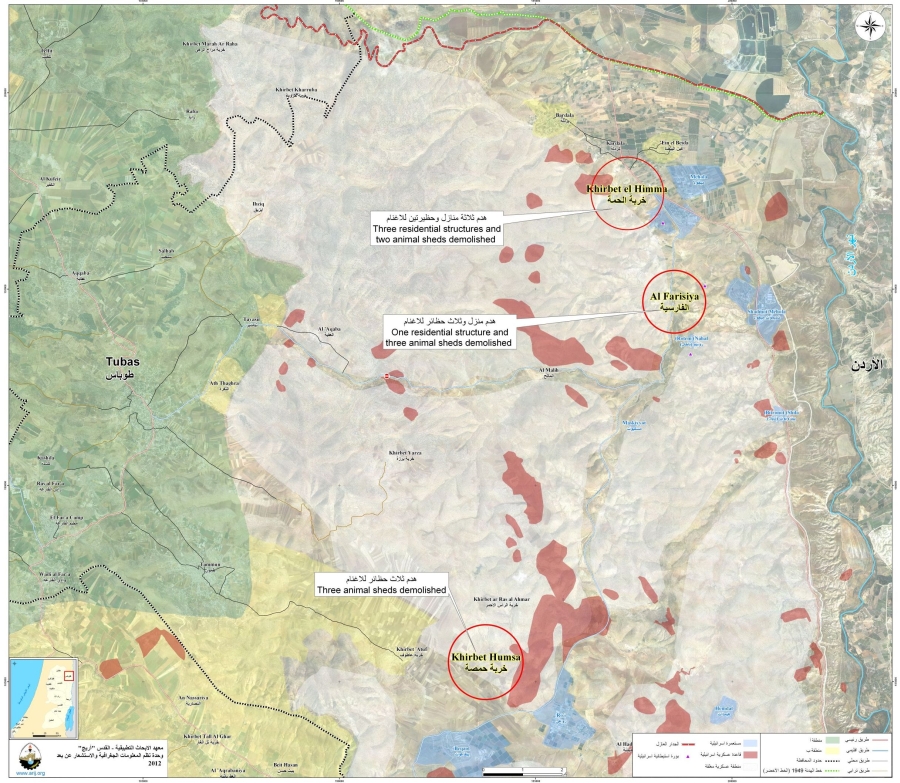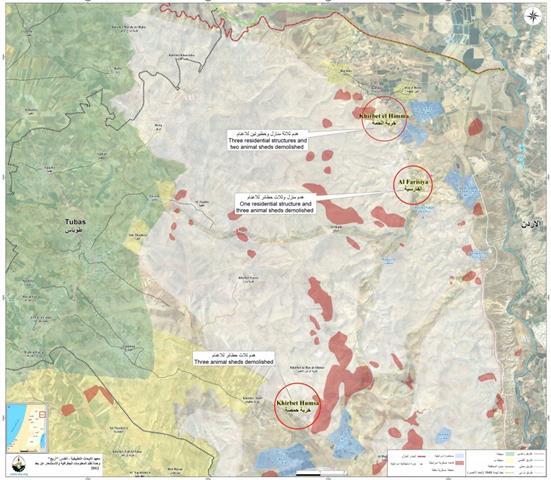The Israeli Occupation authorities are moving forward with their expansionist plans in the Jordan Valley with the aim of cleansing the area from its indigenous Palestinian residents. At the same time, the Israeli colonial practices reached unprecedented levels where in two weeks, 23 Palestinian structures were either demolished or threatened by the Israeli occupation authorities of demolition in different areas in the Jordan Valley.
On March 26, 2012, the Israeli occupation Army bulldozers demolished 12 Palestinian structures in Al-Malih, Al-Faressiyya and Khirbet Humsa Bedouin communities in the northern parts of the Jordan Valley.
-
The first demolition took place in Al-Himma area in Al-Malih Valley (Wadi Al Maleh) when the Israeli bulldozers demolished a house ( inhabited by 6 family members) and an animal shed owned by the local resident Mahmoud ‘Awwad Al-‘Araysha. The Israeli bulldozers also demolished another house and an animal shed owned by the resident Majed Mohammad Hamid Daraghmeh. Moreover and in Al-Himma area, the Israeli bulldozers demolished the house of the resident Ahmad Suleiman Dabak (inhabited by 8 family members) which resulted in the destruction of solar system instruments that were installed on the roof of the demolished house.
-
Al-Farisiyeh community witnessed the second demolition campaign which resulted in the demolition of four structures as follows: a house and an animal shed owned by the resident ‘Ali Zuhdi Abdullah Abu-Mohsen. An animal shed owned by the resident Hussein Zuhdi Abdullah Abu-Mohsen, in addition to the demolition of another animal shed owned by the resident Abed Rabbu Mohammad Abdullah Bani-‘Odeh.
-
Moreover and on the same day, the Israeli bulldozers accompanied by 15 military vehicles stationed in Khirbet Humsa community, and without a prior notification, leveled three animal sheds owned by the local resident Suleiman Abdullah Mohammad Bsharat.

Map 1: the three targeted communities in the Jordan Valley
Al Malih is a Palestinian communities located east of Tubas Governorate in the northern parts of the West Bank. It is bordered by Bardala community to the north, Khirbet Al-Hadidieyyeh to the south, Al-Farisiyeh as well as the Illegal Israeli settlement of Rotem to the east, Al -‘Aqaba and Tayaseer villages to the west.
The area of Al-Malih holds seven Bedouin communities, Al-Hadidiya, Khallet Makhoul, Samra, Al-Hilwa, Wadi Al-Malih, and Al-Himma. The whole area has a total population of around 430 people (PCBS 2012). The area is classified as ‘Area C’ according to Oslo II Interim Agreement of 1995 and falls under full Israeli control. Furthermore, the area holds a mass number of water springs, which are controlled by the Israeli occupation authorities and Israeli settlers, who prevent Palestinian Communities in the Jordan valley area from benefiting from these springs.
Al-Farisiyeh is a Bedouin Palestinian community located to the far east of Tubas Governorate in the northern parts of the Jordan Valley. It is bordered by Mekhola settlement from the north, Rotem and Masskiyot settlements from the south, Al-Malih from the west and Shedmat Mekhola settlement from the east. Al-Farisiyeh is populated by 176 residents (PCBS 2012).
Khirbet Humsa is a Bedouin Palestinian community located to the far east of Tubas Governorate in the northern parts of the Jordan Valley. It is bordered by Khirbet Ras Al-Ahmar community from the north, Beqa’ot settlement from the south, Khirbet ‘Atouf community from the west, Al-Hadidiya community as well as the Israeli settlements of Ro’i and Hemdat from the east. It is a house of 155 residents (PCBS 2012).
To Conclude
The Israeli unjustified demolitions of the Palestinian houses and properties conducted by the Israeli Occupation Army clearly violate the International law rules, conventions and covenants as well as the rules of International Humanitarian Law:
- Articles 53 & 147 of the Fourth Geneva Convention indicated that: Extensive destruction and appropriation of property not justified by military necessity and carried out unlawfully and wantonly. Is a grave breach of the Convention
- Hague Convention IV (18 October 1907): Convention Respecting the Laws and Customs of War on Land: Article (23): ‘To destroy or seize the enemy’s property, unless such destruction or seizure be imperatively demanded by the necessities of war;’
- Article 3 in the Universal Declaration of Human Rights reads that: states that ‘everyone has the right to life, liberty and security of person’.
- Article 25 states that ‘(1) Everyone has the right to a standard of living adequate for the health and well-being of himself and of his family, including food, clothing, housing and medical care and necessary social services, and the right to security in the event of unemployment, sickness, disability, widowhood, old age or other lack of livelihood in circumstances beyond his control.’
- Also Article XXXI, Oslo II, 1995 provides: “Neither side shall take any step that will change the status of the West Bank and the Gaza Strip”.
Prepared by:













